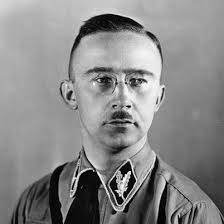But they weren't just interested in big weapons, they studied small ones, like bugs, though not to use them for biowarfare or weird experiments. Hitler had a ban on that.
Yet documents from the period showed the existence of a Waffen-SS Entomological Institute at the Dachau concentration camp. You know what a concentration camp for Germany was designed to do. So if not for biowarfare, why put researchers there? Germany already had several large entomological research centers and the SS was not studying insects because they were worried about protecting food supplies from pests.
After studying the evidence, Tübingen University’s Dr Klaus Reinhardt determined that the institute was intended to combat insect-borne diseases such as typhoid, but it also carried out research into whether mosquitoes – which host malaria – could be used in biological warfare.
Why, if Hitler had a ban on biological weapons? The modern caricature of Hitler would easily lend itself to the idea that he may have officially had one policy while secretly pursuing another, but the reality is that he turned on people quickly if there was even a hint they were not following his commands to the letter, as the careers of brilliant tacticians like Guderian and Rommel showed.
Perhaps some in the upper echelon were immune to Hitler's wrath, or they knew how to keep a secret from him. Perhaps Hitler was only officially banning biowarfare so that the Allies would not escalate and use it also and he would unleash them once they were complete. Or perhaps it was just disease research.
Heinrich Himmler, head of the SS, commissioned the Entomological Institute in Dachau in January 1942, officially after reports of lice infestation among SS troops and following an outbreak of typhoid fever at Neuengamme concentration camp. The instructions Himmler issued were for basic research required to combat germ-carrying insects – involving the life cycles, diseases, predators and preferred hosts of beetles, lice, fleas and flies.

Heinrich Himmler.
Reinhardt says that in 1944, the SS Entomological Institute was tasked with testing various species of mosquito for their ability to survive without food or water – and thus, their suitability to be infected with malaria and air-dropped into enemy territory.
Reinhardt examined notes by the institute’s director, Eduard May. Lab reports detailed experiments with anopheles mosquitoes, which can host malaria during part of its development. May recommended the use of one particular anopheles mosquito species which could survive for more than four days. Reinhardt considers this a clear indicator that the insects were to be used as an offensive biological weapon.
Reinhardt says scientifically more suitable candidates were passed over due to support for May, who was regarded by high command a loyal Nazi. Yet clearly one reason why Dachau was chosen as the location for the insect study facility was due to one of the infamous experimentation programs carried out there – the inoculation of prisoners with malaria by Professor Claus Schilling.
That stunt got Schilling executed at Nuremberg but Reinhardt found no evidence that May collaborated with Schilling in doing it. “May knew that somebody carried out experiments related to malaria in the prisoners’ camp but it is not clear whether he deliberately stayed clear of them or simply was not allowed to enter the prisoners’ camp.”
An SS administration official, Wolfram Sievers, testified at Nuremberg that May had refused to carry out research on human subjects.
Citation: Klaus Reinhardt: The Entomological Institute of the Waffen-SS: evidence for offensive biological warfare research in the third Reich. Endeavour, Vol. 37 No. 4., pp. 220-227 DOI: 10.1016/j.endeavour.2013.05.001






Comments